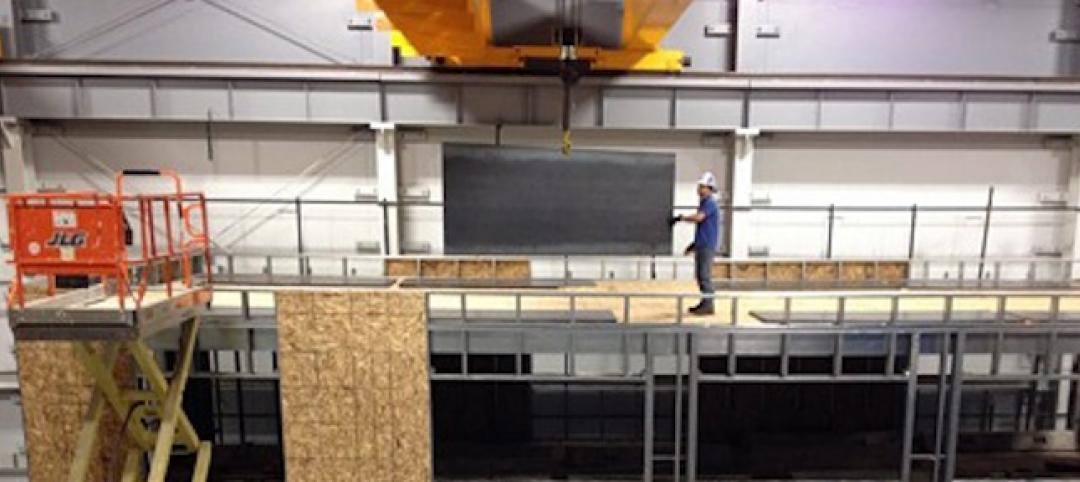The Cuyahoga County Soldiers’ and Sailors’ Monument was dedicated on the Fourth of July, 1894, to honor the memory of the more than 9,000 Cuyahoga County veterans of the Civil War. The small but impressive structure, with a 125-foot column topped by a statue named “Goddess of Freedom,” holds a place of prominence in Cleveland’s Public Square.
In August 2006, the Cuyahoga County Commissioners called for a modest renovation, cleaning, and relighting of the monument, under the supervision of county architect Berj A. Shakarian, AIA, CSI. The $1 million cost was to be raised by a nonprofit foundation, the Soldiers’ and Sailors’ Monument Support Group.
Extensive research by the Cleveland design firm Westlake Reed Leskosky (with Peter van Dijk, FAIA) determined that more extensive work was required than originally anticipated. The roof needed re-caulking. The marble tablets were bent out of shape and discolored. The stained-glass windows needed restoration. In all, the cost would double. Undeterred, the support group raised nearly $2 million from state and county funds and contributions from foundations, businesses, veterans’ groups, and private individuals.
The work began in late 2008. Perhaps the most unusual technical problem had to do with the commemorative tablets. The 4x7-foot slabs, about an inch thick, each weighing 350 pounds, had to be cleaned so that the marble veining could show through the original yellow tint. The traditional technique, mud-based poultice, was ruled out. Research determined that a latex-based cleaning product, if applied and allowed to dry for 13-15 hours, would form a film that could be peeled off. Though tedious, the technique cut the usual cleaning time from three months to three weeks.
Many of the many of the marble slabs were bent out of shape, and the Building Team considered using a method developed by Lord Raleigh in the 1920s—soak the slabs in hot water and bend them back under pressure—but the National Park Service nixed the idea. Instead, to at least stabilize the slabs, the team installed a fin-tube heating system, dehumidifiers, and air-conditioning to control the humidity that was deemed to be the likely cause of the distortion problem.
Detailed research into the marble decoration revealed that the monument had three levels of coloration: tinting (to allow the veining to show through); marbleizing (where veining is augmented or added); and ornamentation (where both tinting and marbleizing are used along with non-opaque colors).
Balancing their research findings, the demands of historical accuracy, and aesthetic interpretation, the team developed a palette of eight colors to restore the original polychromatic interior marbles to their original brilliance. Careful attention was paid to sealing the finishes.
Fourteen Tiffany-style stained-glass windows—two above the entry doors depicting sunrise and sunset, the other 12 portraying military regalia and imagery—were found to be bulging or missing glass. Team members traveled to Chicago to find perfect matches for the missing glass, and the windows were disassembled, repaired, cleaned, and reinstalled.
To enhance the visitor experience, new fluorescent, track, and LED lighting was carefully balanced to enhance the freshly tinted and re-inked lettering of the marble tablets and highlight various accent items.
The final touch had to do with a bronze relief of President Lincoln. Photographic research showed that, as late as 1932, Lincoln was holding the shackles of a freed slave in his right hand, but the shackles had gone missing for more than 40 years. The Building Team restored the shackles in time for the grand reopening last June.
“The research was the most difficult part,” said jurist Tom Brooks, VP, Restoration Division, Berglund Construction, Chicago. Added judge Darlene Ebel, Director, Facilities Information Management, University of Illinois at Chicago, “Restraint was used. It takes a lot of judgment to decide what level of restoration to do. What they did was absolutely right.”
“This is an inspiring project,” said George Karl Tuhowski, III, LEED AP, general superintendent, Leopardo Construction, Hoffman Estates, Ill. “No stone was left unturned.” BD+C
PROJECT SUMMARY
Building Team
Submitting firm: Soldiers’ and Sailors’ Monument Support Group
Owner: Cuyahoga County Soldiers’ and Sailors’ Monument Commission
Architect/Interior design/MEP engineer/Historic specialist: Westlake Reed Leskosky with Peter van Dijk, FAIA
GC: EnviroCom Construction, Inc.
General Information
Size: 1,600 gsf with 125-foot column and statue
Construction cost: $2.0 million
Construction period: May 2009 to May 2010
Delivery method: Design-bid-build
Related Stories
| Jun 14, 2013
First look: Callebaut's eye-popping Möbius building for Taichung arts center
French design firm Vincent Callebaut Architectures has released renderings of "Swallow's Nest," an entry in a design competition for a new cultural center, fine arts museum, and public library in Taichung City, Taiwan. The building, based on a Möbius ring, swirls around a central "Endless Patio."
| Jun 14, 2013
Purdue, industry partners test light steel framing for seismic safety
A partnership of leading earthquake engineering researchers from top U.S. and Canadian universities and design professionals from the steel industry have begun the final phase of a three-year project to increase the seismic safety of buildings that use lightweight cold-formed steel for their primary beams and columns.
| Jun 13, 2013
7 great places that represent excellence in environmental design
An adaptive reuse to create LEED Platinum offices, a park that honors veterans, and a grand national plaza are among the seven projects named winners of the 2013 Great Places Awards. The Environmental Design and Research Association recognize professional and scholarly excellence in environmental design, with special attention paid to the relationship between physical form and human activity or experience.
| Jun 13, 2013
Richard Smith joins Cannon Design Science + Technology practice
Cannon Design, an internationally ranked architectural, engineering and planning firm, is pleased to announce Richard Smith has joined the firm as a Principal. Smith joins the leadership team for Cannon Design’s Science + Technology (S&T) practice and will focus on developing strategies for immediate and long-term growth.
| Jun 13, 2013
Winfrey hired as Health and S&T studio head for SmithGroupJJR Dallas
SmithGroupJJR, one of the nation’s largest architecture, engineering and planning firms, has hired David Winfrey, AIA, LEED AP BD+C, as leader of its Health and Science & Technology Studio at its Dallas, Texas office.
| Jun 13, 2013
WorkingBuildings acquires Specialty Operations Solutions
The WorkingBuildings Companies, a leading provider of comprehensive Owner-based solutions for the built environment, announces the acquisition of Specialty Operations Solutions (SOS), a national provider of research and laboratory services.
| Jun 13, 2013
Health Product Declaration Collaborative names Knott as Executive Director
John L. Knott Jr. has been named as the Health Product Declaration Collaborative’s (www.hpdcollaborative.org) first Executive Director following a national search. The Health Product Declaration Collaborative (HPDC) is a customer-led standards-setting organization committed to the continuous improvement of the building industry’s environmental and health performance, through transparency and innovation in the building product supply chain.
| Jun 13, 2013
AIA partners with industry groups to launch $30,000 'Designing Recovery' design competition
The program will award a total of $30,000 to three winning designs, divided equally between three locations: Joplin, Mo., New Orleans, and New York.
| Jun 12, 2013
More than 90% of New York City schools have code violations
More than 90% of New York City schools have at least one outstanding building code violation. Loose wires, stuck doors and inadequate ventilation are just some of the problems.
| Jun 12, 2013
5 building projects that put the 'team' in teamwork
The winners of the 2013 Building Team Awards show that great buildings cannot be built without the successful collaboration of the Building Team.















